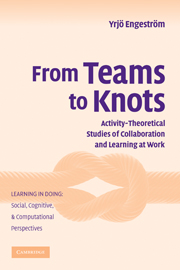Book contents
- Frontmatter
- Contents
- Series Foreword
- Preface
- 1 Teams and the Transformation of Work
- 2 Disturbance Management and Masking in a Television Production Team
- 3 Teamwork between Adversaries: Coordination, Cooperation, and Communication in a Court Trial
- 4 Displacement and Innovation in Primary Care Medical Teams
- 5 Crossing Boundaries in Teacher Teams
- 6 Knowledge Creation in Industrial Work Teams
- 7 Teams, Infrastructures, and Social Capital
- 8 From Iron Cages to Webs on the Wind
- 9 Knotworking and Agency in Fluid Organizational Fields
- References
- Author Index
- Subject Index
- Titles in the series
2 - Disturbance Management and Masking in a Television Production Team
Published online by Cambridge University Press: 05 June 2012
- Frontmatter
- Contents
- Series Foreword
- Preface
- 1 Teams and the Transformation of Work
- 2 Disturbance Management and Masking in a Television Production Team
- 3 Teamwork between Adversaries: Coordination, Cooperation, and Communication in a Court Trial
- 4 Displacement and Innovation in Primary Care Medical Teams
- 5 Crossing Boundaries in Teacher Teams
- 6 Knowledge Creation in Industrial Work Teams
- 7 Teams, Infrastructures, and Social Capital
- 8 From Iron Cages to Webs on the Wind
- 9 Knotworking and Agency in Fluid Organizational Fields
- References
- Author Index
- Subject Index
- Titles in the series
Summary
Teams are not always dynamic and innovative. To the contrary, they are often breeding grounds of defensive routines and protective encapsulation. These phenomena have not often been studied in detail in real organizational settings. In this chapter, I will ask why a seemingly very successful team did not learn, why it stagnated and resisted change and innovation.
The pervasive influence of information technologies on work is turning communication into a key component of an increasing number of work processes that have traditionally been considered as predominantly instrumental constellations of jobs or man-machine systems. Zuboff (1988) characterized this change as proliferation of informated work. The transition is reflected in the birth and rapid growth of new fields of research, such as computer-supported cooperative work (CSCW) (e.g., Bowers & Benford, 1991; Greenberg, 1991; Schmidt & Bannon, 1992) and distributed cognition (e.g., Galegher et al., 1990; Hutchins, 1995; Rasmussen, Brehmer, & Leplat, 1991; Resnick, Levine, & Teasley, 1991; Salomon, 1993). Prominent organizational theorists have begun to incorporate these issues and ideas in their work (e.g., Weick, 1993; Weick & Roberts, 1993).
These changes make the Habermasian separation of communicative and instrumental action (Habermas, 1984) all but useless for concrete analysis. Communication is increasingly intertwined with core productive processes. Thus, it is increasingly difficult to understand or change organizational communication without understanding and changing those core productive processes.
In this chapter, I will analyze one process of production, namely, the production of a live TV sports broadcast.
- Type
- Chapter
- Information
- From Teams to KnotsActivity-Theoretical Studies of Collaboration and Learning at Work, pp. 22 - 47Publisher: Cambridge University PressPrint publication year: 2008

